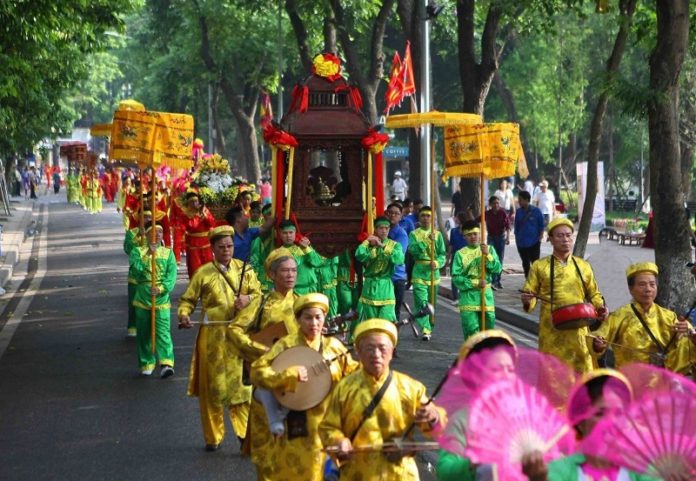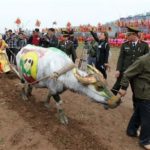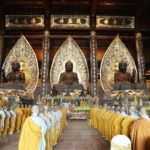A grand festival to mark the 595th anniversary of King Le Thai To’s coronation (1384-1433) is set to take place at the King Le Thai To Monument, located at Hoan Kiem Lake in Hanoi, from June 2nd to June 4th.
| A traditional palanquin procession around Hoan Kiem Lake will be held on June 3 to pay tribute King Le Thai To (1384-1433). Photo: VNA |
The festival will feature a plethora of spiritual rituals, cultural activities, and performance arts, including an incense offering ceremony with a traditional palanquin procession around Hoan Kiem Lake; a photo exhibition capturing the essence of Vietnamese traditional festivals on the sidewalks of Sword Lake; an exhibition of Hang Trong folk paintings at Nam Huong Communal House; the captivating human chess performance on Le Thai To Street; and material arts performances on the pedestrian street of Hoan Kiem, among many others.
The annual Le Loi Festival is a celebration of Le Loi’s great service during the 10-year uprising against the Chinese Ming invaders. It is also an opportunity for people to learn about ancestor worship and preserve traditional spiritual and cultural values. As part of the festivities, locals enjoy traditional music, dance, and folk art. This event serves as a reminder of the rich history of Vietnam and the courage and bravery of its people.
He reigned from 1428 to 1433 as the third king of the Vietnamese Le Dynasty. He is best known for his resistance against the Chinese Ming Dynasty’s occupation of Vietnam and for his subsequent victory at the Battle of Bach Dang in 1426.
King Le Thai To, born Le Loi, is one of the most celebrated figures in Vietnamese history and a renowned hero of the country. He held the throne from 1428 to 1433 as the third monarch of the Vietnam’s Le Dynasty. He is widely remembered for successfully leading the Vietnamese people in their struggle against the Chinese Ming Dynasty’s occupation of Vietnam and for his triumphant win at the Battle of Bach Dang in 1426.
The illustrious King also earned his pre-imperial title as Binh Dinh Vuong, or Prince of Pacification, who founded the later Le dynasty after restoring independence to the kingdom of Dai Viet (Greater Vietnam) by defeating the Chinese Ming invaders.
| An illustration of legendary history of the Sword Lake. File photo |
In 1418, Le Loi and his followers launched the Lam Son Uprising to revolt against the rule of the Ming dynasty in his homeland. He is renowned for his effective guerrilla tactics, which involved the constant movement of small, agile units of soldiers to ambush regular Ming troops. By using this strategy, Le Loi was able to surprise, overwhelm and defeat the Ming forces time and time again.
Nine years later, his resistance movement achieved a major victory by successfully expelling the Ming army from Vietnam and liberating the nation.
This king is also fabulous because of his connection to the history of Sword Lake. Legend has it that Hoan Kiem Lake is where King Le Loi returned his magic sword to the Golden Turtle after defeating the Ming Empire, and since then it has been named Hồ Gươm or “Sword Lake” or Hồ Hoàn Kiếm or “Restored Sword Lake”.
In 1894, the grand statue of King Le Thai To was erected by Hoang Cao Khai, the former viceroy of Tonkin (1850-1933), in front of the Nam Huong Communal House on the scenic Hoan Kiem Lake.
Today, the iconic King Le Thai To Memorial and Nam Huong Communal House in Hang Trong Ward, Hoan Kiem District of Hanoi form a complex of ancient and dignified historical and cultural relics, preserving and celebrating Vietnamese cultural traditions in the capital city.
Since 1995, Nam Huong Communal House and King Le Thai To Memorial have been listed as part of the Ho Guom Monument Cluster and recognized as a National Historical Monument by the Hanoi Municipality.
| The Nam Huong Communal House bears strong imprints of Hanoi’s history, culture, and people. Photo: VOV |
Tam Chuc Pagoda – Ancient beauty amidst majestic scenery
Covering 5,100 ha, Tam Chuc complex is a perfect combination of ancient beauty and the mighty of the immense mountain.









